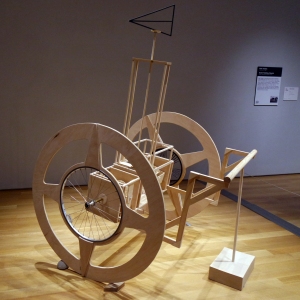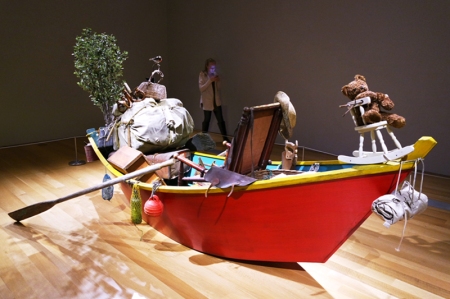Every September, Grand Rapids, Michigan is transformed into a public art gallery known the world over as ArtPrize.
This massive event could not exist without its use of technology – in fact, one of its 10 guiding principles is “ArtPrize Embraces Technology.”
Proprietary Technology
A major technical element of ArtPrize is its extensive website. This is where public or private spaces can register to be official ArtPrize venues, artists can propose their ArtPrize entries and be matched with a host venue, and visitors can find information on the event, as well as on individual entries. Perhaps most importantly, the website allows the public to vote for their favorite pieces in the public vote contest, in which $300,000 in prize money is available to artists. Once a visitor has registered as a voter (they must be within the vicinity of ArtPrize to do so), they can cast their vote in three different ways: on the website, through text/SMS, and now through the official ArtPrize app.
Yes, the event’s voting system is entirely electronic. While this certainly increases efficiency and accuracy in tallying votes, and prevents dishonest voting practices, this dependence on technology has backfired in the past. In 2015, the voting system was down for about six hours on the opening day of ArtPrize because of a service outage (Francis, 2015). It’s unknown just how much that glitch affected the voting overall, but it could have contributed to a decrease in voter turnout: the number of registered voters in 2015 was 15 percent less than in 2014 (Harger, 2016).

Ori Gersht’s “On Reflection” at the GRAM
Historically, a small percentage of ArtPrize attendees have actually registered to vote – less than 20 percent of 1.9 million people in the first seven years (Harger, 2016). It is easy to enjoy the event without voting, but imagine how different the public vote contest could look if more people would take the time to register and vote. It’s possible the reliance on technology is preventing people from voting; perhaps they would prefer not to share their personal information with ArtPrize, or their access to technology is limited. It will be interesting to see how voter participation trends in the future, especially if changes are made to the voting process.

Maarten Baas’ “Sweeper’s Clock” at the GRAM. A working analog clock…in digital video format.
The ArtPrize mobile app is much more than a tool for voting, as it was developed to provide “an authentic visitor experience, where technology enables a human-to-human connection and a real experience with contemporary art” (Woods, 2016). The human-to-human connection comes in especially with the Lists feature, which is also available on the ArtPrize website. Visitors can create lists of their favorite entries or pieces they want to see, or curate lists based on themes or media used. App users can share their lists with others via social media and email.
Beyond the voting and lists, the app essentially serves as a guide for ArtPrize visitors, with maps for venues, parking, restrooms, and handicap accessible options; updates and news from ArtPrize; and information on art, artists, and events.

Kate Conlon’s “South Pointing Chariot” at the GRAM
Other Uses of Technology
In 2014, ArtPrize organizers found an opportunity with a digital signage pilot program the Rapid bus system had been testing. Throughout ArtPrize, “the digital signage system was interfaced with ArtPrize social media to provide passengers with updated information,” such as the most popular entries and where to find them, and upcoming events or performances (Zirlin, 2015). The signage allowed the captive audience of passengers to learn about the event in real-time, whether or not they were planning to attend. This created an experience on public transit that was memorable and useful, adding value to the ArtPrize brand.
Social media opportunities have also been implemented by individual ArtPrize venues. In 2011, Mercantile Bank installed touch-screen kiosks in their pop-up gallery. Visitors could snap digital photos and directly upload them to Facebook, where the visitors would be “checked in” at the venue. The photos were also uploaded to Mercantile’s Facebook page, and randomly selected images were transmitted to three digital billboards around Grand Rapids (Chen, 2012). This ambitious project was a clever way for the venue to increase its exposure while giving value to its visitors during ArtPrize. There is a lot of opportunity for venues to adopt similar tactics in the future.
Finally, any discussion of technology and ArtPrize would be lacking without mention of how technology factors into the art itself. Many artists have used new or old technologies (or traces of them) as part of their pieces or in creating their pieces, or have submitted art that causes the viewer to question their relationship to technology.
For instance, are our gadgets distracting us from the world right in front of us?

Girl on smartphone near David Greenwood’s “Starting Over” at the GRAM
ArtPrize has created a phenomenon in the art world as it seeks to make art more accessible to everyone. The many forms of technology used within and around ArtPrize have contributed to that cause, but there is still plenty of room to grow.
References
Chen, A. (2012). Ask a social media guru – Part II. Independent Banker, 62(6), 18-19. Retrieved from http://search.proquest.com.ezproxy.gvsu.edu/docview/1238733700?accountid=39473
Francis, E. (2015, September 23). ArtPrize kicks off despite technical glitches. FOX 17. Retrieved from http://fox17online.com/2015/09/23/artprize-kicks-off-despite-technical-glitches/
Harger, J. (2016, September 19). Why you can and should vote in ArtPrize 2016. MLive. Retrieved from http://www.mlive.com/artprize/index.ssf/2016/09/why_you_can_and_should_vote_in_artprize_2016.html
Woods, J. (2016, July 26). ArtPrize introduces new mobile experience [Blog post]. Retrieved from https://www.artprize.org/blog/artprize-introduces-new-mobile-experience
Zirlin, B. (2015). Create an informational ride with digital signage. Mass Transit, 41(2), 24. Retrieved from http://search.proquest.com.ezproxy.gvsu.edu/docview/1690093188?accountid=39473
